As described in our last article, the Project Catalyst funded “Swahili Learn to Earn” project provided funding for Lido Nation to build a Swahili language Cardano education program with 75 modules and quizzes. Swahili is widely spoken in southeast Africa, a target area for Cardano impact. Users who speak Swahili could register for the program, connect a Cardano wallet, take daily quizzes as they learned, and ultimately earn up to $25 dollars worth in ADA.
In many ways, this project was both a proof of concept and an experiment.
- Could we build the platform, and what challenges could we solve along the way?
- How easy could we make it for brand new users to create Cardano wallets and collect rewards?
- Would enough people be interested in participating?
- How difficult would it be to prevent abuse of the system?
The stated goals of the project were to onboard HUNDREDS of new Cardano users in Africa, opening brand new wallets, seeding those wallets with a little bit of ada, and educating the users about blockchain, Cardano, and how they could participate in the ecosystem, including in Project Catalyst. It felt ambitious and exciting, and we weren’t sure how it would all work out!
As of this writing, all the deliverables of the project have been met, and we will be submitting our project close report. The project will continue to run on Lido Nation until the incentivization fund is exhausted, and then we hope to start building a V2 based on what we have learned. But for now – let’s take a look at the results!
Site Traffic and Geographic Targets
During the run of the program in May-June, the Swahili Learn to Earn landing page was visited 10K times by 591 unique visitors. The geographic heat map of unique visitors based on website analytics is as follows:
- Kenya: 432
- Congo: 101
- Rwanda: 30
- USA: 30
- United Kingdom: 3
- Ghana: 3
- Canada: 1
- Portugal: 1
- Tanzania: 1
- Uganda: 1
It makes sense that our biggest reach was in Kenya - that is where our apprentices are based at the Ngong Road Blockchain lab, and they were invaluable in getting the program started with word of mouth. We also partnered with the DirectEdDev Cardano project to share our program with their Kenyan students. The strong showing from Congo is largely due, we believe, to the initiative taken by leaders of the Goma stakepool community in Congo to introduce the program to users there. We had much lighter footprints in other Swahili-speaking countries, but they did just start to show up on the site! The program has only been “live” for about 6 weeks, so it seems likely that with a longer run, it could start to catch on throughout a wide swath of Swahili-speaking Africa.
Learners Registered
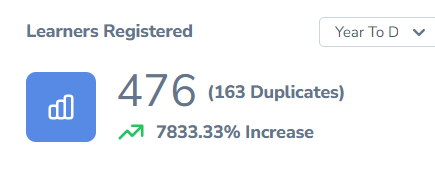

We had 476 unique learners registered in the program before we “turned off” registration. We decided it was best to turn off registration because, given the reward budget of the project, we only have enough ada for 350-400 learners to earn the full $25 dollars of ada per learner. If we let registrations continue to higher numbers, there would be many learners who learned that the reward pot was “empty” before they had done many lessons at all!
This issue and the need to turn off registration was one that I did not entirely anticipate. I thought that it would be more difficult to recruit and engage learners, and that the full numbers might trickle in over a number of months. I also thought that not all registered learners would fully engage. I thought some would hopefully take all the courses, but that others would not bother to log in every day for the next module.
Instead, it took only 5 weeks to fill our ranks, and learner engagement is extremely high. We went from 4-5 registrations per day for a couple weeks, to about ten per day, to 20, to 30, to 60, to 130. The peak in the “Registered Users Per Day” chart is the jump from 60 to 130, which brought our overall registration from ~340 to ~470+ in a single day. We had started to realize we would need to turn off registration sometime soon the day before, and within 24 hours it became an urgent matter!
You can also see the results of our duplicate-detection efforts in the “Learners Registered” chart. The numbers show that we have 476 valid/unique learners, plus 163 accounts that we identified as duplicates: learners trying to open multiple accounts.
I’ll also note that we have implemented a “waiting list” sign up for potential learners who find the program after we closed registration. With the great interest we experienced, we would have loved to welcome all comers! Gathering a waiting list could help us to measure and demonstrate the level of interest in this style of learning for similar projects in the future.
Wallets & Staking
The hope for this project was to reach and onboard NEW Cardano users, and see an increase in Cardano Wallets opened in Africa. So did that happen? We do have to acknowledge that in some ways it’s impossible to know with precision - we do have the wallet addresses of participants, but wallets don’t come with geographic tags or easily extractable “age” reports. However, we can extrapolate from the data we do have.
First of all, this program was available only in Swahili, which is spoken widely in south east Africa, and not widely anywhere else. That fact plus our site traffic data support the fact that we really did reach a lot of people in Africa.
Next, the wallet data of registered users paints a picture that suggests that the vast majority of users really are Cardano newbies. Of the 476 registered users, only 314 have connected their wallets as of this writing. This number has lagged at a similar rate over the run of the program because these users simply do not have Cardano wallets when they get started. They do learn how to create and connect a wallet in the first steps of the course, and they have to do this to collect rewards. But the consistent lag demonstrates that learners are not coming in with Cardano wallets already in hand – they are learning and creating them for the first time!

Furthermore, we see that as of today, only 4% of registered wallets in the program are staked to any pool. Of course we would like this number to ultimately grow, as users learn the benefits of staking and how easy it is to participate. However, it makes sense that the number of staked wallets is very low to start; it supports the conclusion that these really are brand new users, who simply have not figured out staking yet.
Quizzes & Learning
The next question is: do registered users participate repeatedly and consistently? Again, the results exceeded my expectations. Our users have so far completed reading and taking almost 3K quizzes. The reward budget will cover rewards for a total of about 25K total quizzes, so we are about 10% of the way there. Considering that fully ¼ of our participants registered literally YESTERDAY - we expect and have already seen that the RATE of quiz consumption will jump considerably. Again, I expected the full run of the course would take any number of months, but it seems clear that from this writing, the reward cycle will be nearly complete in about a month.
The Response Correctness chart shows how learners are performing on the quizzes. I would not hope to see a 100% correct response rate, as that would suggest the questions are too easy. I would also be concerned if the rate was extremely low - that could indicate spammy interactions with the program, or suggest that learners might be frustrated by the material. However, the correctness rate has hovered between 83-88%, which seems about right to me. It’s clear that learners are reading enough to understand and select the right answer most of the time, but are still finding themselves challenged now and then.
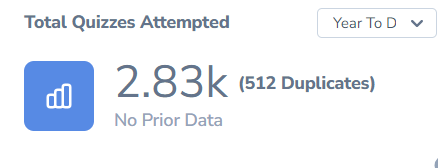

An interesting note is that the response correctness rate has ticked UP in the most recent days. I don’t know why specifically, but I have a guess that it may correlate to a few organized groups of learners that joined in the last days. This group from Goma|Wada posted a video and photo of a new cohort of learners that they onboarded:
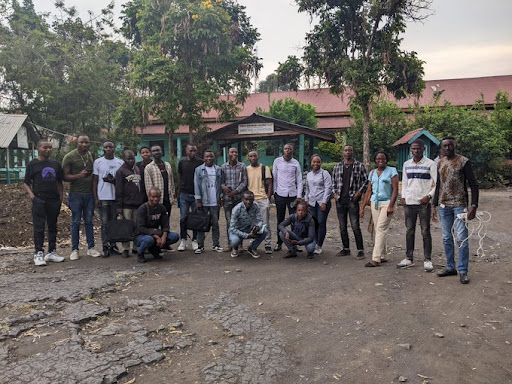
Working together, we would expect that all the learners would figure out the right answer together, and could push up the overall correctness average. This is exciting - but not because we care that learners get the right answers the first time. Rather, we believe that a supportive community will lead to overall more impactful outcomes!
Reward Distribution
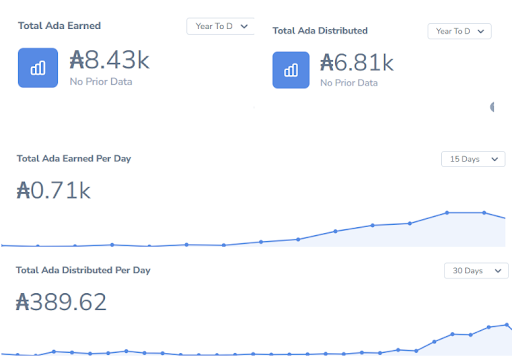
Finally, here is a report on ada rewards earned and distributed. The way the program is set up is that learners earn their $1 worth of ada each time they take a daily quiz. Then, they can go to a different page to withdraw their earnings. Hypothetically, learners could wait and let their earnings add up before doing a bulk withdrawal. They might do this because they are still working on getting their wallet set up and connected, or because they don’t want to take the extra step of withdrawal every day. This is why there is a gap between Total Ada Earned vs Total Ada Distributed. However you will notice that it is a fairly small gap. What we have learned with this program is that even a small incentive is quite compelling, and our learners don’t want to collect their rewards later - they want them right away, every day! This was a learning for us, since I think we expected all of the learner interactions to be much slower and more relaxed than it has been. We have found instead that there has been a need to provide a fair amount of customer support and reassurance when there is even a slight delay in the daily rewards distribution. It’s a small price to pay for the fun of working with an excited and motivated audience of learners.
Looking ahead
The key question this program asked was: is incentivized learning an effective way to reach and onboard new users in Africa?
The answer has been a resounding YES.
Having seen such remarkable success, our minds jump to how we can build on it.
- We know that $25 in ada IS sufficient motivation. What if it was $10 in ada? What if it was HOSKY or other network tokens? Experimenting with different incentives could allow us to attract more users with a given budget.
- How can we help learners transition from onboarding to more/ongoing participation in Cardano? Can we get them to stake to a pool? To participate in Project Catalyst? Are there other Cardano projects we could bridge with?
- What are the gaps in the current curriculum? What additional content would be most relevant and helpful to new users in Africa?
The key learning in this project is that to make incentivized learning secure and scalable, an identity solution is absolutely necessary. The Lido Nation team is already researching Decentralized Identity (DID) solutions, and dreaming about what we can build next.
As Project Catalyst is back in action and we think about what is next, we would love to hear your thoughts and ideas about what you would like to see in the future of this project.


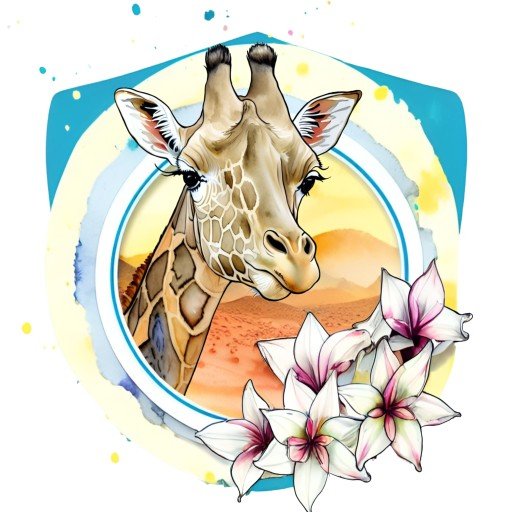
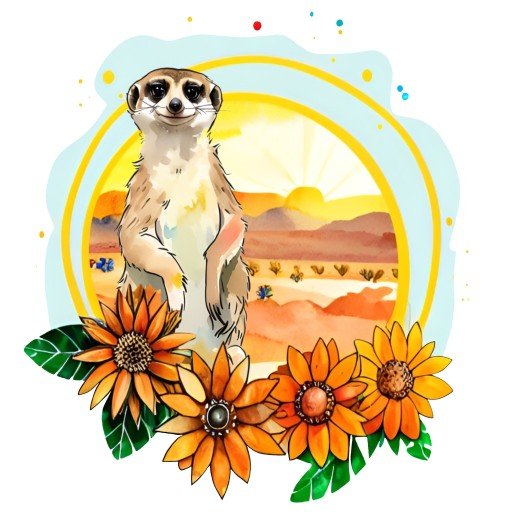
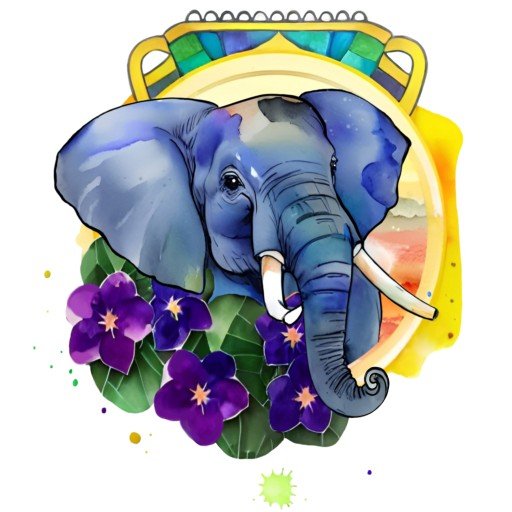
No comments yet…